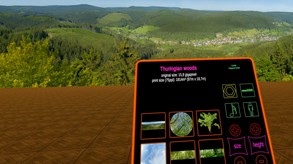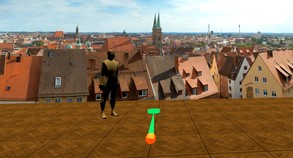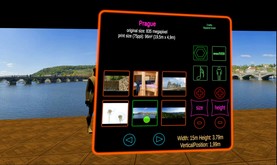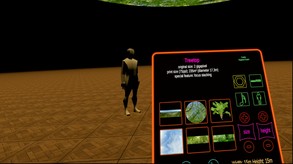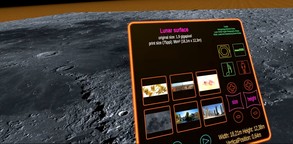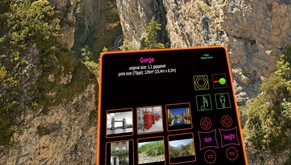VR Gigapixel Gallery (PC)
About this game
The "Gigapixel VR Gallery" is an opportunity to view extremely high-resolution pictures in various sizes exactly up close in 6DoF.
The gallery has 48 motifs ranging from 136 megapixels to 15.9 gigapixels. One gigapixel is 1000 megapixels. There is also an option to switch between the high resolution with a resolution of 25 megapixels. This helps to understand what influence the distance to the image has for qualitative perception. The closer you are to the subject, the more important it is that the resolution is high enough. One of three factors limit the perception:
1. Technical limit of VR glasses
2. Resolution of the image
3. Resolution of the eye.
Since the size of the image can be individually adjusted, it is easy to reach the limit of the resolution of the eye. Of course, with today's technological level, this means that the resolution of VR glasses is the real limiting factor. If you want to perceive the resolution between different headsets in real situations, apart from the technical specifications, you have a good tool at hand for a subjective optical benchmark.
Updates of further images
This project is more a matter of the heart than somehow making money professionally.
Should enough money come in with this project to cover the costs of the creation, there will be an expansion package with additional motifs free of charge. We definitely don't lack motifs. We are also happy to take requests for what motifs you want to see more. E.g. Cities, nature, architecture, macro, etc.
NASA/ESA
There are two images in the gallery, which were taken by the Hubble telescope (NASA/ESA). These images in the gallery are scientifically incorrect, because we have optimized them with aesthetic perception in mind and we also corrected certain image errors.
Metric system
As you can see, we use the metric system. For many English-speaking areas, the conversion to the metric system has already taken place, at least in part. For our friends in the US, Myanmar and Lyberia, who have not yet benefited from the metric system, they should definitely take a look at it. Not that it happens again, that e.g. NASA destroys an orbiter because they forgot to convert because the rest of the world used the logical metric system (Mars Climate Orbiter 1999).
1 in = 0.0254 m
1 ft = 0.3048 m
1 yd = 0.9144 m
1 mi = 1609.344 m
1 in² = 0.00064516 m²
1 ft² = 0.09290304 m²
1 yd² = 0.83612736 m²
1 mi² = 2589988.110336 m²
Diffraction is the real culprit
For everyone who makes the effort to read the text here, here is something nice to know:
There are various limits in digital photography that affect the resolution of the image. Diffraction counts as the often underestimated value. Camera manufacturers promise a huge resolution sensor, but this can only be used in very specific situations and is usually just a marketing idea. If we ignore all other influences (which additively worsen everything further), a full-frame camera (24x36mm) with an aperture of 8 only has the possibility to bring about 30 megapixels of information to the sensor due to diffraction. At aperture 11 it would be 15 megapixels and at aperture 16 it would only be 7.5 megapixels. Conversely, the resolution increases with a smaller f-number. At f / 5.6 it would be 60 megapixels, at f / 4 it would be 121 megapixels. You might think that everything is fine, when you use a maximum aperture of 5.6 with a 50 megapixel 35mm camera. There are two problems with this. The lesser problem nowadays is the optimal sharpness of the lens, since this is technically well solved, that it is reasonably homogeneous over a few aperture steps. The bigger problem is that the higher the resolution of the image, the lower the sharpness level, especially the closer the subject is. This means that if you are not close to the infinity focus of the lens, the focus level will be too small if you use a small f-number. This inevitably leads to focus stacking in order to achieve a greater depth of field, which in turn leads to other problems (keyword movement). Or you can just downsize the image.
This as a small digression, why pictures often look bad, even though you think you have a sufficiently high-resolution camera. If you have any questions on this topic, we would be happy to help, just contact us.
Here are a few approximate values for diffraction and sensor size at aperture 8:
Compact camera 2/3 “(7x9mm): 2.2 megapixels
MicroFourThirds (13x17mm): 8 megapixels
APS-C (16x17mm): 13.5 megapixels
Full frame (24x36mm): 30 megapixels
Medium format small (30x45mm): 47 megapixels
Medium format large (40x53mm): 76 megapixels
The bottom line from this information is also that there is no commercially available camera, which at aperture 8 can create even one of the high-resolution images with a single image here, unless the currently known physics is turned upside down.
Género
educaciónEditores
Gigapixel GmbHEnlaces
Steam
Fecha de salida
Julio 1, 2020
SOs compatibles
HMDs compatibles
Entrada
Forma de juego
Idiomas
- Textos en inglés
Comentarios (0)




















